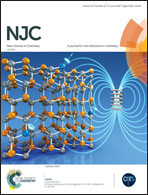A bifunctional NiCo2S4/reduced graphene oxide@polyaniline nanocomposite as a highly-efficient electrode for glucose and rutin detection†
Abstract
A novel NiCo2S4/reduced graphene oxide@polyaniline (NiCo2S4/rGO@PANI) composite was synthesized by a facile two-step hydrothermal treatment and calcination, which was coupled with an in situ polymerization process. A bifunctional electrochemical sensor was developed for glucose electrocatalysis and rutin oxidation based on this composite modified glassy carbon electrode (GCE). The as-prepared composite was characterized by transmission electron microscopy (TEM), scanning electron microscopy (SEM), X-ray photoelectron spectroscopy (XPS), X-ray diffraction (XRD), electrochemical impedance spectroscopy (EIS), thermogravimetric analysis (TGA), and Fourier transform infrared spectroscopy (FT-IR). Furthermore, the NiCo2S4/rGO@PANI/GCE composite displayed excellent electrocatalytic activity towards glucose in the linear range of 1–7000 μM and a detection limit of 0.14 μM (S/N = 3). And for rutin, the linear range was 0.01–200 μM with a low detection limit of 0.007 μM (S/N = 3). The sensitivity of this sensor for glucose and rutin was evaluated to be 4.924 and 75.50 μA μM−1 cm−2, respectively. In addition, this sensor delivered high selectivity, good reproducibility, and long-term stability. The modified electrode was also employed to determine glucose in human blood serum samples and rutin in orange juice, buckwheat tea, and compound rutin tablet samples.



 Please wait while we load your content...
Please wait while we load your content...